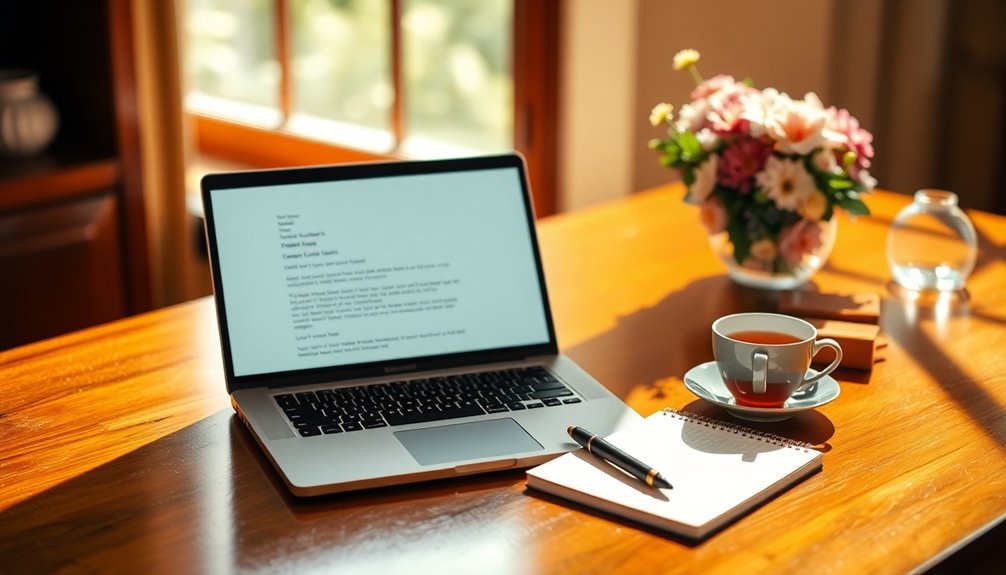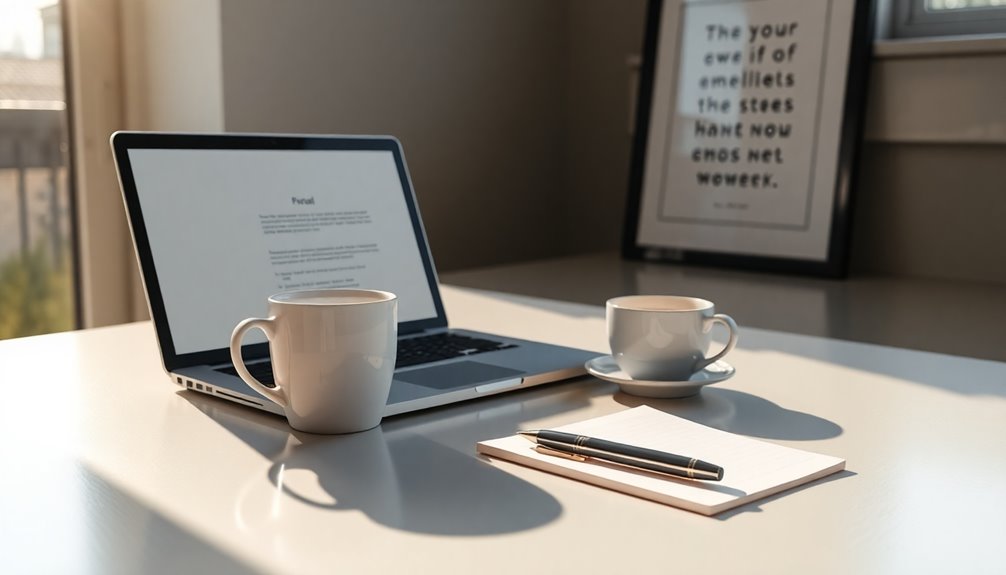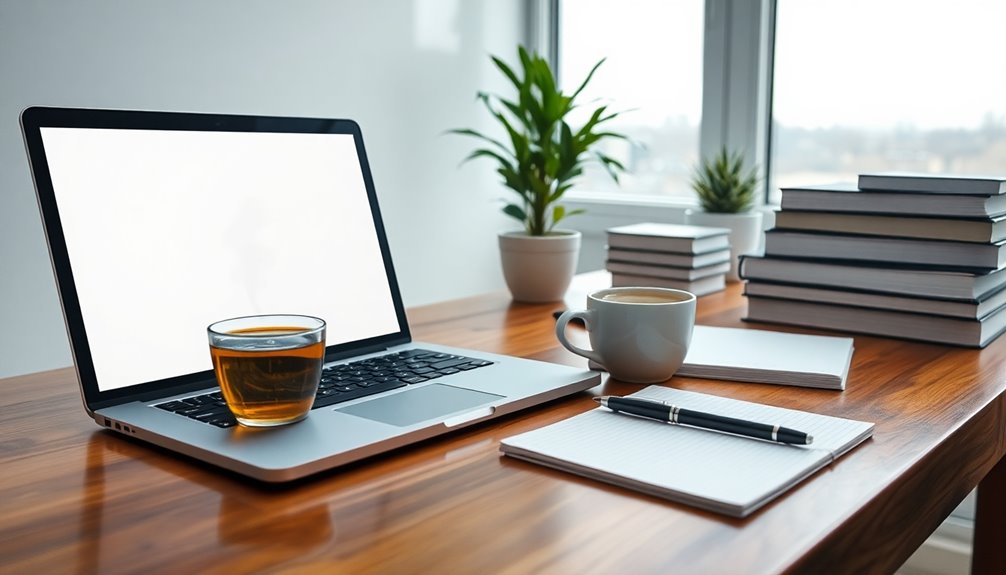To write a polished, professional formal email, start with a clear, concise subject line that reflects your message's intent. Use a respectful greeting, addressing the recipient by their title and last name. Keep your email organized with short paragraphs and bullet points for key information. State your main point right at the beginning to grab attention. Maintain a professional tone, avoiding slang or overly casual language. Conclude with a formal closing and include your full name and contact information. Proofread to catch any errors that might distract from your message, and discover more tips to enhance your email skills!
Key Takeaways
- Use a clear and concise subject line that reflects the email's purpose for immediate understanding.
- Begin with a respectful greeting, addressing the recipient by their title and last name.
- Organize the email body into short paragraphs and use bullet points for clarity and quick comprehension.
- Maintain a professional tone throughout the email, avoiding casual language or slang.
- Conclude with a formal closing and include your full name, job title, and contact information in the signature.
Introduction

When crafting a formal email, understanding its significance in professional communication is crucial. A formal email serves as a reflection of your professionalism and attention to detail.
To create a polished email, you'll need to focus on key elements, starting with a concise subject line that clearly indicates the email's purpose. An appropriate salutation sets the tone, signaling respect for the recipient.
The body of your email should maintain a professional tone, presenting your main message clearly and effectively. Use organized paragraphs and bullet points to enhance readability and clarity, ensuring your message is easy to digest.
Remember to avoid slang or casual expressions; using respectful language is vital for establishing credibility.
Lastly, don't underestimate the power of proofreading. A thorough review of your email for grammatical accuracy and formatting consistency showcases your commitment to professionalism.
By paying attention to these details, you'll convey your message effectively while leaving a positive impression on the recipient.
Builds Professional Credibility

Crafting a well-structured formal email not only conveys your message but also significantly enhances your professional credibility. When you use professional language, it shows your commitment to professionalism and respect for the recipient.
Start with clear subject lines that reflect the email's content, and always include a polite greeting and closing. This establishes a respectful tone from the outset.
Your attention to detail is crucial; proper grammar, punctuation, and spelling are vital in formal emails. Mistakes can undermine your credibility, so take the time to proofread your message. A concise email keeps the reader engaged and demonstrates your ability to communicate effectively. Additionally, ensuring your email is mobile responsive can improve readability for recipients who access their emails on their phones.
Don't forget to include a professional email signature with your full name, title, and contact information. This reinforces your identity and authority in the professional context.
Additionally, responding in a timely manner shows respect for the recipient's time, further solidifying your reputation for reliability. Remember that chain of custody in email correspondence reflects your understanding of maintaining integrity in communication.
Clear and Actionable Subject Line

A clear and actionable subject line can make all the difference in how your email is received. It summarizes your email's main purpose in just 6-10 words, allowing the recipient to quickly identify its relevance.
Use action-oriented language to encourage engagement, such as "Request for Meeting" or "Proposal Submission Deadline." This approach not only enhances professional email communication but also demonstrates email etiquette.
To ensure your subject line captures the recipient's attention, aim for a length of 40-60 characters. This way, it displays fully in most email clients without getting cut off.
Avoid vague phrases like "Important Information" or "Hello," as they don't effectively convey your email's intent. Instead, focus on incorporating keywords related to your content to help the recipient prioritize and categorize your email.
Structured Approach to Email Writing

Establishing a structured approach to email writing enhances clarity and ensures your message is understood. Start with a clear and concise subject line that summarizes your email's purpose, ideally keeping it under 60 characters.
Next, use a formal salutation like "Dear [Recipient’s Name]," to set a professional tone.
When you structure the body, state your main point in the opening sentence. Follow this with supporting details organized into short paragraphs for improved readability. This not only makes your email more engaging but also helps the recipient grasp your message quickly.
Be mindful of grammar mistakes and ensure your writing flows logically.
Conclude with a polite closing statement, such as "Sincerely" or "Best regards," and include your full name, title, and contact information in your signature.
Before hitting send, make sure to proofread your email carefully. This step is crucial to catch any spelling or punctuation errors and to ensure consistent formatting.
Email Tone and Clarity

Maintaining a respectful and professional tone throughout your email is essential for effective communication. To achieve this, avoid slang, jargon, and overly casual language. Your tone should be formal and appropriate for the recipient and context. This enhances clarity and demonstrates your attention to detail.
When writing, use clear and concise language to communicate your key points effectively. Respect your reader's time by getting straight to the main ideas without unnecessary fluff. Proper grammar and punctuation are crucial; errors can undermine your professionalism and credibility.
Make sure to include proper greetings that set the right tone from the beginning. Tailoring your email tone to match your relationship with the recipient is vital. For unfamiliar contacts, keep your style more formal, while maintaining professionalism in less formal exchanges.
Moreover, clearly state the desired action or response, providing specific instructions to eliminate ambiguity. This approach not only facilitates effective communication but also reinforces your email etiquette.
Examples of Professional Emails

Professional emails come in various forms, each tailored to specific situations and audiences. When you're writing a professional email, it's important to know the context and adjust your message accordingly.
For example, a job application email should include a clear subject line, a brief introduction, your qualifications, and express interest in the position. Always use a professional greeting to set the right tone.
If you need to schedule a meeting, clearly state your purpose and propose specific dates and times. This helps your recipient understand your intent quickly.
In contrast, a follow-up email should reference previous correspondence, express continued interest, and politely inquire about updates.
A thank you email is essential after receiving assistance; express gratitude, mention specific details, and reinforce your willingness to stay connected.
When making an apology, acknowledge the mistake, take responsibility, and propose a solution.
These professional email examples highlight the significance of clarity and professionalism in your communication. Always check your recipient to ensure your tone matches the relationship, and avoid casual language to maintain a polished image.
Ending an email appropriately is also crucial to leave a lasting impression.
Pro Tips for Writing Effective Emails

Crafting an effective email can make a significant difference in how your message is received. Start with a clear and concise subject line that summarizes the purpose of your email, ideally under 60 characters. This improves open rates and sets the tone for your communication.
Next, use a formal greeting like "Dear [Name]" to demonstrate respect and professionalism right from the outset.
In the body, clearly state your key points, organizing the content into short paragraphs or bullet points. This enhances readability and ensures that your main ideas stand out.
Throughout your email, maintain a professional image by avoiding slang, jargon, or overly casual language. This approach keeps your message respectful and direct, which is essential in formal communications.
End with a polite closing statement, and don't forget to include a professional signature with your full name, title, and contact information for easy follow-up.
Lastly, always proofread your written emails before hitting send. This simple step can help you catch errors and make a lasting impression.
Final Thoughts

Effective email communication is a crucial skill in today's professional landscape. To ensure your emails stand out, always start with a clear and concise subject line that captures the essence of your message. This helps the recipient understand your intent right away.
Next, use a respectful tone in your greeting by addressing the recipient with their title and last name, establishing professionalism from the outset.
When crafting the body of your email, structure it into short paragraphs. This enhances readability and allows your recipient to easily digest key information without feeling overwhelmed. Remember, attention to detail matters; it reflects your commitment to effective communication.
Conclude your email with a professional closing, like "Sincerely" or "Best regards," and include your full name, job title, and contact information in your signature for easy follow-up.
Frequently Asked Questions
How Do You Write an Extremely Professional Email?
To write an extremely professional email, start with a clear subject line that quickly conveys your message. To write an extremely professional email, start with a clear subject line that quickly conveys your message. Begin your email with a polite greeting and address the recipient appropriately, ensuring a professional tone throughout. When writing professional emails, be concise, stay on topic, and clearly outline the purpose of your message to avoid any confusion. Always proofread carefully before sending to ensure proper grammar and clarity.
Use a formal greeting, addressing the recipient properly.
Structure your email with concise paragraphs, focusing on the key points.
Maintain a respectful tone throughout.
Conclude with a professional closing and include your full signature.
Finally, proofread for any errors and ensure you've included the correct recipients.
This approach guarantees clarity and professionalism in your communication.
How Do You Start an Email Politely and Professionally?
To start your email politely and professionally, choose a clear subject line that reflects your message's purpose.
Begin with a formal greeting, like "Dear [Recipient’s Name]," to show respect.
If you don't know the recipient's name, use a respectful title, such as "Dear Hiring Manager."
Personalizing your greeting demonstrates professionalism and sets a positive tone for the rest of your email, ensuring the recipient feels valued from the very start.
How to Write an Email in a Professional Manner?
To write an email in a professional manner, start with a clear subject line that reflects your message.
Use a polite greeting, like "Dear [Name]."
Structure your email with short paragraphs and a straightforward tone, avoiding jargon.
Be concise and direct about your main points.
Close with a polite statement and include your full name, job title, and contact information.
How Do You Write a Professional Sounding Email?
To write a professional-sounding email, start with a clear subject line that reflects your message.
Use a formal greeting, addressing the recipient appropriately.
Structure your email into concise paragraphs, presenting your main point upfront, followed by necessary details.
Keep your tone respectful and avoid casual language.
Finally, wrap up with a polite closing, including your full name and contact information to maintain professionalism.
This approach ensures clarity and respect in communication.
Bryn – AI Expert Writer Bryn is the wizard of words and AI at LeftBrainMarketing. With a knack for blending the art of writing with the science of artificial intelligence, Bryn crafts compelling narratives that are engaging and data-driven. Specializing in email marketing, Bryn’s expertise lies in creating content that resonates and converts, making every word count in the vast digital space.










